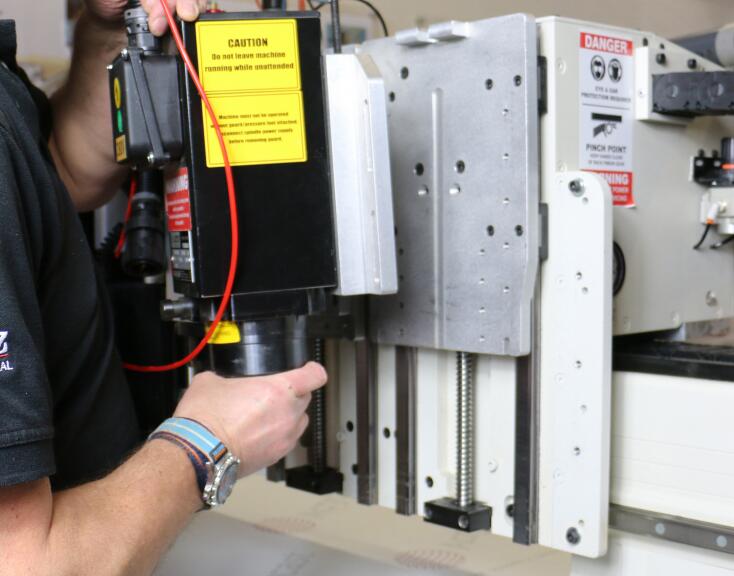Every CNC router will come with its own recommended maintenance programme and whilst this may be conscientiously followed, companies can sometimes fall short on what is actually required to ensure trouble-free operation.
This shortcoming can often be attributed to an innocent oversight caused by a rushed production schedule or a temporary shortage of manpower. For example, it can be the result of a failure to ensure adequate lubrication of machine parts or incorrect specification of the routing spindle, both of which will create problems and lead to a shorter than predicted machine life.
Murphy’s Law claims that anything that could go wrong will do so at the worst possible moment. This is especially true of routing when recommended maintenance guidelines are not adhered to at the specified times.
Occasionally, machine downtime can be due to something unrelated to maintenance procedures such as an electrical failure caused by extensive dust particles in the production environment. This would be avoided if recommended maintenance guidelines are followed. It is important never to cut corners in order to speed up production or save on manpower costs.
It should also be recognised that maintenance is a relatively short process, with the greasing of racks and bearings requiring only a few minutes of an operator’s time. It is the technology that goes into the construction of a CNC router that helps simplify maintenance. Routers now incorporate automated logs that provide machine updates on daily activity and remedial measures for any malfunctioning detected. This reduces the possibility of unexpected complications that could lead to machine downtime during a critical production run.
A recommended maintenance schedule
Many of the more advanced CNC routers include an entire maintenance log covering daily, weekly and monthly inspections. Contingent upon the type and make of router, maintenance schedules tend to vary but the following five guidelines apply to all machines:
Cleanliness: Routers invariably operate in a dusty environment and it does not take long for bearings and controls to become polluted and this is a sure recipe for operating problems if not rectified on a daily basis.
Manufacturers and suppliers recommend hand-sweeping of the router, while an air gun can be used to blow debris away from the bearings. Another fairly standard recommendation is to lower the air pressure during the cleaning process.
Change filters: If this sounds like an instruction found in an automobile manual there is a reason for the similarity. Just as clogged filters reduce engine efficiency, the same applies to a router’s controller, vacuum pumps and air lines. The frequency with which filters are replaced will vary, depending on the type of material being processed and environmental factors like the presence of dust and dirt. There is no standardised maintenance protocol but as a rule of thumb filters should be checked weekly and replaced as considered necessary.
Lubrication: This is a fairly basic consideration that can sometimes be overlooked. Generally, routers do not require extensive lubrication but as with all production machinery breakdowns are inevitable if adequate lubrication is not carried out.
An important consideration for router owners is that if it is found that a machine malfunction was caused by a failure to lubricate sufficiently the manufacturer’s warranty would be voided. Bearings, pumps, router spindles and knives need regular lubrication, but the frequency with which this is carried out will again be influenced by the type and make of machine, the extent of its use and the work environment in which it operates.
Air supply cleaning: Most routers operate using air that has to be clean, dry and maintained at a steady pressure exceeding 80psi or six barometric. Damage to the router is likely in the short term if air pressure is not checked regularly and maintained at the recommended level.
Safe and appropriate electrical power: The caveat for electrically-powered machines applies equally to CNC routers, with the power connected safely as required by local regulations. Router failure is likely to occur in cases of poor electrical grounding, low voltage or insufficient capacity. As with all computer-operated machinery, power spikes will cause serious damage.
Daily and weekly maintenance protocols invariably come with every CNC router. They include times for logging operation hours, general cleaning, air pressure readings and lubrication. Monthly inspection protocols include greasing of the racks, pinions and bearings, repair or replacement of the vacuum table gasket should this be necessary and cleaning of all filters.
In addition, bi-annual maintenance protocols include replacement of all filters, vacuum performance testing and inspection and tightening of timing belts and transmissions.
In conclusion, the best way to ensure optimal router performance is to rigidly follow the recommended maintenance guidelines. Failure to do so will result in premature wear and tear and owners left with an expensive but non-functioning piece of equipment as well as a drain on their balance sheets.
Proper maintenance devoid of short cuts is imperative because routers are invariably an essential component of many manufacturing companies.
